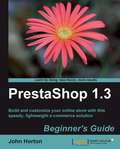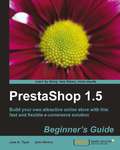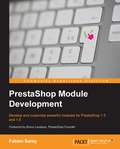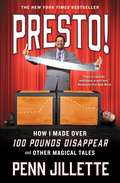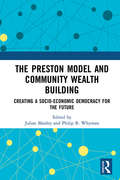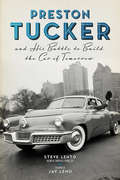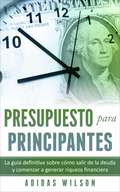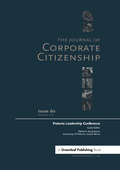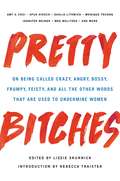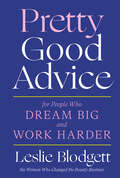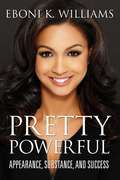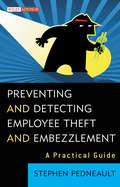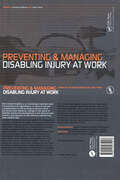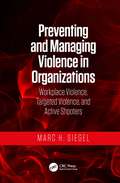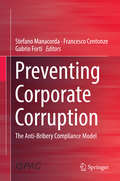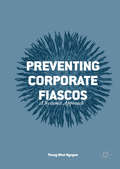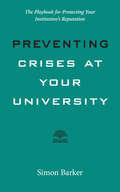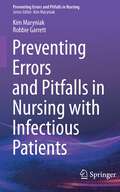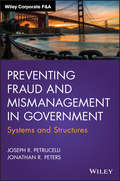- Table View
- List View
PrestaShop 1.3 Beginner's Guide
by John HortonThe book is structured so that following the chapters in order leads to building a fully functioning and live trading PrestaShop. Guidance is also given should you wish to learn or practice your skills in an offline, non-trading environment. Every chapter contains clearly structured and illustrated step-by-step explanation to achieve the goals discussed. Nothing is left for readers to work out themselves, but it would be very simple for them to use the information to go beyond the specific tutorials, should they wish to do so. There is optional additional reading, including more than a dozen specifically written downloadable e-books made available on the book's support website just for readers of PrestaShop 1.3 Beginners Guide. This book is for anybody who wants a fully functioning e-commerce store using PrestaShop. You do not have to have any previous knowledge of PrestaShop or any aspect of e-commerce or business in general. If you do, then you will probably find this guide really valuable as well. The book covers all you need to know about starting your own e-commerce business.
PrestaShop 1.5 Beginner’s Guide
by Jose A. Tizon John HortonThis book is written in a friendly voice with lots of tips, tricks, and screenshots to help you set up, extend, and personalize your own online shop. If you want to start your own e-commerce business, then this book will help you do that.This book is for people who are interested in creating an online shop. Basic HTML and CSS skills would be beneficial but are not required as we will provide you with all the code and know-how you need.
PrestaShop Module Development
by Fabien SernyIf you are a developer who is new to PrestaShop and wants to get a good foundation in development on the PrestaShop framework, this book is for you. It's assumed that you will have some experience with PHP5, jQuery, and HTML/CSS (no need to be an expert on it).
Prestige Telephone Co.
by William J. Bruns Jr.An independent regulated telephone company has established a computer services subsidiary that seems to remain unprofitable. Managers must determine whether it is profitable or not and consider changes in pricing or promotion that might improve profitability. A rewritten version of an earlier case.
Presto!: How I Made Over 100 Pounds Disappear and Other Magical Tales
by Penn JillettePenn Jillette’s New York Times bestselling account of his “extremely funny and somewhat profane journey to discovering a healthy lifestyle…that will motivate others to seek weight-loss solutions” (The Washington Post).More than three hundred and thirty pounds and saddled with a systolic blood pressure reading at dangerous heights, legendary magician Penn Jillette found himself at a crossroads. He needed a drastic lifestyle change if wanted to see his small children grow up. Enter Crazy Ray. A former NASA scientist and unconventional, passionate innovator, Ray Cronise changed Penn Jillette’s life with his wild “potato diet.” In Presto, Jillette takes us along on his journey from skepticism to the inspiring, life-changing momentum that transformed the magician’s body and mind. He describes the process in hilarious detail, as he performs his Las Vegas show, takes meetings with Hollywood executives, hangs out with his celebrity friends and fellow eccentric performers, all while remaining a dedicated husband and father. Throughout, he weaves in his views on sex, religion, and pop culture, making his story a refreshing, genre-busting account. Outspoken, frank, and bitingly clever, Presto is an incisive, rollicking read. In the end, it is “undeniably inspiring” (Booklist).
The Preston Model and Community Wealth Building: Creating a Socio-Economic Democracy for the Future
by Julian ManleyThrough a deep examination of what has become known as the ‘Preston Model’, this book explores an innovative approach to local economic development that utilises economic democratisation to realise both social and economic objectives. The first part of the book examines the main strands of the Preston Model framework and what makes it different to other urban regeneration schemes: the combination of local anchor institution procurement to generate and retain local wealth, and the development of cooperatives to fill gaps in local supply chains. The chapters in this section consider the Preston Model as viewed through different lenses: politics and society, community, economics, democracy, trade unionism, language and communication, education and transferability. The second part explores the influences and applications of the Preston Model, in theory and practice, in selected locations and various circumstances worldwide. This includes discussion of key ideas such as economic democracy, social enterprise and the creation of capacity for cooperative self-government, alongside essays on prominent international examples of similar approaches, which can inform and in turn be informed by the Preston Model. This book is essential reading for those interested in regional and national policy, economic democracy and alternative economic and political ideas.
Preston Tucker and His Battle to Build the Car of Tomorrow
by Jay Leno Steve LehtoIn the wake of World War II, the U.S. automobile industry was fully unprepared to meet the growing demands of the public, for whom they had not made any cars for years. In stepped Preston Tucker, a salesman extraordinaire who announced the building of a revolutionary new car: the Tucker '48, the first car in almost a decade to be built fresh from the ground up. Tucker's car, which would include ingenious advances in design and engineering that other car companies could not match, captured the interest of the public, and automakers in Detroit took notice. Here, author Steve Lehto tackles Tucker's amazing story, relying on a huge trove of documents that has been used by no other writer to date. It is the first comprehensive, authoritative account of Tucker's magnificent car and his battles with the government. And in this book, Lehto finally answers the question automobile aficionados have wondered about for decades: exactly how and why the production of such an innovative car was killed.
Presupuesto para Principantes: La guía definitiva sobre cómo salir de la deuda y comenzar a generar riqueza financiera
by Adidas WilsonDecidir que necesita crear un presupuesto es una cosa. Crearlo y ejecutarlo es otra. Esto es algo que muchas personas conocen y comprenden. Algunos siguen adelante y crean un presupuesto, e incluyen metas financieras que no son realistas. Pero si usted desea presupuestar con éxito, debe considerar una estrategia de varios pasos en lugar de cometer errores comunes al presupuestar o tener excusas presupuestarias. Si ha intentado hacer un presupuesto antes y ha fallado, intente incorporar estos pasos la próxima vez. La gente falla por muchas razones. Uno de ellos es tener poca fe en los presupuestos y no ver cómo pueden ayudarlo a mejorar su situación financiera. Puede sentir que no gana lo suficiente para su presupuesto. Entonces, antes de comenzar a presupuestar, establezca sus metas.
Pretoria Leadership Conference: A special theme issue of The Journal of Corporate Citizenship (Issue 60)
The Albert Luthuli Centre for Responsible Leadership invited papers related to responsible leadership from a trans-disciplinary perspective involving the social and natural sciences. Subsequent to a lengthy review process, fifteen authors were invited to present at the the 3rd International Conference on Responsible Leadership; from these, five papers were finally selected to appear in this Special Edition.Management, leadership, and business knowledge by itself cannot ensure a sustainable and equitable future. What is needed is an integration of knowledge about responsible leadership across disciplinary boundaries, ranging from management studies and the physical sciences, to law, the humanities and social science. Only by integrating across current disciplinary boundaries can we find hope for generating what has been termed “earth system governance”, a way for humanity to manage the complexities of the world to create a just, equitable, and sustainable world for all.The five papers included in this special edition provide insight into responsible leadership and the importance of interdisciplinary dialogue in an interconnected and complex world. The perspectives converge to give us focused insights on responsible leadership as an emerging discourse, confirming the importance of bridging science, business and politics, and the role that responsible leadership plays in this.
Pretransformation: Planting the Seeds
by Behnam TabriziPretransformation is the first stage of a transformation effort and holds special importance in setting the tone for the effort. This chapter examines the general steps you must take to plant the seeds for a successful transformation effort, from how to select a transformation leader to how to gain buy-in and momentum.
Pretty Bitches: On Being Called Crazy, Angry, Bossy, Frumpy, Feisty, and All the Other Words That Are Used to Undermine Women
by Lizzie SkurnickThese empowering essays from leading women writers examine the power of the gendered language that is used to diminish women -- and imagine a more liberated world.Words matter. They wound, they inflate, they define, they demean. They have nuance and power. "Effortless," "Sassy," "Ambitious," "Aggressive": What subtle digs and sneaky implications are conveyed when women are described with words like these? Words are made into weapons, warnings, praise, and blame, bearing an outsized influence on women's lives -- to say nothing of our moods.No one knows this better than Lizzie Skurnick, writer of the New York Times' column "That Should be A Word" and a veritable queen of cultural coinage. And in Pretty Bitches, Skurnick has rounded up a group of powerhouse women writers to take on the hidden meanings of these words, and how they can limit our worlds -- or liberate them. From Laura Lipmann and Meg Wolizer to Jennifer Weiner and Rebecca Traister, each writer uses her word as a vehicle for memoir, cultural commentary, critique, or all three. Spanning the street, the bedroom, the voting booth, and the workplace, these simple words have huge stories behind them -- stories it's time to examine, re-imagine, and change.
Pretty Good Advice: For People Who Dream Big and Work Harder
by Leslie Blodgett“[A] new literary genre, the MBA Memoir . . . Delivers 97 pearls of warmth, wit and wisdom from the most inspirational entrepreneur I have ever met.” —Frances Edmonds, bestselling author of Repotting Your Life Called the “Queen of Beauty” and the most influential lone woman to impact the beauty industry since Estée Lauder by the New York Times, Leslie Blodgett’s story is anything but ordinary. As the CEO of BareMinerals, she reinvented how beauty was sold by tapping into the power of community before the idea of social media existed. In 2006, Blodgett took the company public in one of the largest cosmetic IPOs of the decade, and in 2010, the company was acquired for $1.8 billion. Pretty Good Advice is her next chapter. This refreshing book features 97 candid and entertaining insights on business, life, and beauty. Personal and often surprising, Blodgett dishes on leading with humor, why wearing blush and reading obituaries are two of the most optimistic things you can do, and why you owe it to your coworkers not to be boring. Pretty Good Advice is full of frank, actionable advice to help light a fire under you.“If you want to laugh, get totally inspired, learn a bunch and enjoy reading something so engrossing you won’t put it down but you could because it’s written in these amazing one-ish-page chunks, GET IT. Could not be better for right now.” —Jean Godfrey June, Beauty Editor, GOOP“A moving and clear-eyed memoir of an extraordinary life. Charmingly made-up as a how-to guide, Leslie chronicles that life in vivid and memorable lessons that jump off the page.” —John W. Evans, author of Should I Still Wish
Pretty Powerful: Appearance, Substance, and Success
by Eboni K. WilliamsFOX News co-host and radio personality Eboni K. Williams believes that women shouldn’t hide their beauty. Instead, they should embrace it as a positive and powerful asset. Williams describes how her own career has been positively influenced by making strategic and intentional decisions about her appearance, what works best and when, all while staying true to her own personal style and values. Regardless of the decade, whether they were entering the workforce, seeking a leadership role, or looking to ascend to the C-suite, women (and even men) have always felt the professional need to embody a certain aesthetic appeal and individual personal power. Women, especially, have been sold the lie that being “pretty” comes at the expense of being taken seriously and that being “pretty” and being capable are mutually exclusive. In PRETTY POWERFUL, Eboni K. Williams encourages readers to reject the knee-jerk reaction to be shamed by this potential advantage and to stop leaving this incredibly powerful asset unused. In each chapter, Williams is joined by other powerful women like Meghan McCain, Marcia Clark, and Desiree Rogers and explores how many others have learned to balance their “prettiness” with substance—to both look the part and express their intelligence in a way that is authentic and respected. While opinions may have differed through time, one fact remains: a personal “pretty” brand is perhaps the most immediate and obvious tool in a woman’s professional arsenal.
Prevailing Worldviews of Western Society since 1500
by Glenn Richards MartinThis text is a concise study of the conflicting worldviews we face today. It is published from lectures and retains the author's engaging style. Dr. Martin analyzes the structures and procedures which inform government, law, economics, and international relations. He links these institutions to their underlying philosophical and theological roots.
Prevent Senior: A New Paradigm for Growth in the Health Care Sector?
by Regina E. Herzlinger Ana Maria Malik Priscilla ZogbiCase
Prevent Senior: A New Paradigm for Growth in the Health Care Sector?
by Regina E. Herzlinger Ana Maria Malik Priscilla ZogbiCase
Preventing and Detecting Employee Theft and Embezzlement
by Stephen Pedneault"If you don't think that some employees have figured out ingenious ways to steal from businesses, read this book. The real-life examples will change your mind. " -Joseph T. Wells, CFE, CPA, founder and Chairman, Association of Certified Fraud Examiners "An easy-to-read, but comprehensive step-by-step approach that covers every potential area for employee fraud and embezzlement. Great checklists at the end of each chapter show what steps to put into place for controls and protection. Includes real-life examples that really 'bring the story home. ' " -Jean L. Conover, CPA, past CEO/CFO, Jefferson Radiology PC "This book is a must-read for seasoned entrepreneurs as well as those considering entering their own business venture. While developed for small business, the risk detection and prevention methodologies presented by Mr. Pedneault are universal to all businesses. The concise checklists provide ready guidance for establishing a complete system of controls. "-Denise H. Armstrong, CPA, Chief Financial Officer, Sea Research Foundation, Inc. d/b/a Mystic Aquarium and Institute for Exploration "This book is a must for every individual owning their own business. Mr. Pedneault clearly articulates the fraud risks that occur in each business system. In the book, he offers practical advice for internal controls and illustrates the risks with real-life examples. "-Leonard W. Vona, President, Fraud Auditing, Inc.
Preventing and Managing Disabling Injury at Work
by Terrence Sullivan John FrankThis unique reference reveals what works best in preventing workplace disability. Preventing and Managing Disabling Injury at Work examines the changing nature of the workplace and work force and includes recent information on effective early and staged multi-modal interventions in the workplace. The text also explores psychological risk perception and the essential linking of the workplace, clinician, insurer, and worker in the recovery process and in the prevention of subsequent disability events. Well-illustrated with case studies and practical examples, much of the book focuses on the common musculoskeletal disabilities and regional disorders along with other, broader applications.
Preventing and Managing Violence in Organizations: Workplace Violence, Targeted Violence, and Active Shooters
by Marc H. SiegelOrganizations of all types and sizes, whether they are a business, educational institution, healthcare provider, or house-of-worship, need to plan for the possibility of violent acts that may impact its people, assets, and activities. Preventing and Managing Violence in Organizations: Workplace Violence, Targeted Violence, and Active Shooters provides a comprehensive approach to addressing workplace violence, active shooter and assailant events, and other forms of targeted violence. The book takes a unique perspective that the prevention and management of violence in an organization is a risk and business management issue, rather than a siloed security issue. As such, the book’s objective is to help organizations develop a program for preventing and managing violence that can be integrated into their day-to-day overall business management approach. The main theme of the book is that any program to prevent and manage violence in an organization needs to be an inclusive process: where everyone in the organization is viewed as a risk maker and risk taker, and therefore, a risk manager. The emphasis is on building a risk and security awareness culture in the organization so that everyone throughout the organization is aware and part of the solution. The book recognizes that many, if not most, organizations do not have a dedicated chief security officer to oversee the prevention and management of violence. It also recognizes that many resource allocation decisions are made by business managers, not the security manager. While other books approach this issue from a security perspective, this book takes the perspective that providing a safe and secure environment within the organization, and protecting its people, assets, and activities, is a business management imperative. Therefore, the book emphasizes the need to promote a risk and security awareness culture that is integrated into the organization's system of management and all its activities and functions. The "Introduction" section of the book includes a brief description of violence in organizations and the imperative for integrating the prevention and management of violence into the organization’s overall business management strategy. The "Framework" section helps business, human resource, risk, security, and safety managers build a programmatic framework to support prevention and management of violence in all the organizations activities. The "Tactics and Control Measures" section provides tactical and operational advice and tools on methods to prevent, respond to, and recover from potentially violent events. For organizations that have adopted an ISO, Robust Process Improvement, or Six-Sigma management systems approach, they will immediately recognize that the elements described in the framework can be integrated seamlessly into their overall management system approach. Preventing and Managing Violence in Organizations illustrates a systems approach for preventing and managing violence in organizations that can also be used for managing other types of operational risks. Security managers will find the book useful for integrating security in the organization’s day-to-day activities—as an integral part of these activities—rather than an add-on activity. Security professionals will be able to present their program from a business and risk management perspective.
Preventing Corporate Corruption
by Stefano Manacorda Francesco Centonze Gabrio FortiThis book presents the results of a two-year international research project conducted for the United Nations Office on Drugs and Crime (UNDOC) to investigate and provide solutions for reducing bribery and corruption in corporations and institutions. It starts with an empirical case study on the effectiveness of a set of self-regulation rules adopted by multinational companies in the energy sector. Second, it explores the context and factors leading to corruption internationally (and the relationships between domestic criminal law and self-regulation). Third, it examines guidelines for the adoption of compliance programs developed by international institutions, to serve as models for the future. The principle result of the book is a three-pronged Anti-Bribery Corruption Model (so called ABC Model), endorsed by the United Nations, intended as a corruption prevention tool intended to be adopted by private corporations. This work provides a common, research-based standard for anti-bribery compliance programs, with international applications. This work will be of interest to researchers studying Criminology and Criminal Justice, particularly in the areas of organized crime and corruption, as well as related areas like Business Ethics and Comparative International Law.
Preventing Corporate Fiascos
by Thang Nhut NguyenThe lasting effects of corporate fiascos on business and the economy have spurred investigations, panel discussions, and research in an attempt to find out why these events happen and ways to prevent them. Through case studies and analysis of bankruptcy and institutional collapse, Preventing Corporate Fiascos examines the root cause of these disasters and offers a management exceptions system that diagnoses potential failure from the start. Dr. Nguyen's unique framework is inspired by the biological spectrum, using cancer and disease as a metaphor for prevention and destruction. He uses a proven management repertory grid technique to evaluate aberrant and emotionally-charged decisions which could bring an institution to collapse. By recognizing the institution, its employees, the market and the economy as components of the biological spectrum, we can identify aggravating failure and disease and begin to take effective steps toward prevention.
Preventing Crises at Your University: The Playbook for Protecting Your Institution's Reputation (Higher Ed Leadership Essentials)
by Simon R. BarkerA new playbook for effective crisis management in higher education.Unlike other industries, in higher education an institution's most important asset is its reputation. Yet as fundamental as it is, many leaders continue to view managing reputation as dishonest and counterproductive, a suspect process that undermines the very idea of reputation as an organic outcome of reality. When leadership credibility is on the line, though, and an institution's reputation is facing potentially irreparable damage, the concept of reputational risk moves from being nebulous to all too tangible. In Preventing Crises at Your University, Simon Barker demonstrates how critical it is for colleges and universities to align strategy and values with decision-making during times of crisis. Arguing that leaders must stop considering the discussion of reputational risk as unseemly, he demonstrates that this discussion is in fact a strategic imperative for every leader. Significant reputational damage, Barker asserts, is not the inevitable outcome of a crisis but of a poor response. Defining a new crisis leadership playbook to deal with self-inflicted crises, he also• explains what typically goes wrong in a crisis;• describes how to prevent crises from escalating;• demonstrates how a stakeholder-centric model of communications can help mitigate reputational damage; and• introduces a number of original concepts, including a Reputational Risk Management Framework, a Reputational Risk Maturity Model, and a Culture and Capability matrix.Moving beyond the theoretical by presenting case studies of real crises involving sexual assault, freedom of speech, student protests, faculty misconduct, and a broad range of financial, social, and ethical issues, the book highlights and underscore key concepts around effective management of reputational risk. Ultimately, Preventing Crises at Your University serves as a wake-up call for all higher education leaders and board members.
Preventing Errors and Pitfalls in Nursing with Infectious Patients
by Kim Maryniak Robbie GarrettThis book informs nurses about the most common and the more serious errors made in caring for patients with infectious diseases. It provides learnings about a variety of infectious diseases, including COVID-19, methicillin-resistant Staphylococcus aureus (MRSA), Vancomycin-resistant Enterococcus (VRE), Clostridium difficile (C-diff.), and tuberculosis (TB), amongst others. Factors that are predisposing and contributing factors for nursing errors are reviewed. The types of errors, consequences, detection, and monitoring for nursing errors are included. This book examines how errors can be avoided with necessary precautions, and managed appropriately based on current evidence-based practice. Recommendations for further study are also provided. This book is a useful tool for nurse educators/ leaders/mentors to educate and guide their students and professional nurses.
Preventing Fraud and Mismanagement in Government: Systems and Structures
by Jonathan R. Peters Joseph PetrucelliDig to the root of public fraud with deep exploration of theory, standards, and norms Preventing Fraud and Mismanagement in Government identifies common themes in public fraud and corruption, describes the forces that drive them, and provides an objective standard of good practices with no political bent. From Bridgegate to Iran-Contra, this book walks through the massive scandals that resulted from public mismanagement and fraud to illustrate how deeply-entrenched, entity-specific norms can differ from actual best practices. The discussion includes the theoretical underpinnings of public fraud, and how intense corporate culture and limited exposure to outside practice standards can lead to routine deviation from normal behavior and moral standards. You'll find a compendium of practices that illustrate actual norms, allowing you to compare your own agency's culture and operations to standard practice, and contrast the motivations for fraud in the public and private sectors. Public agencies and governmental entities are generally driven by a pubic benefit or goal, but are widely varied in the ability and desire to deliver value while retaining best practices. This book explicitly explores the common patterns of agency practices and cultural norms, and describes how they can easily cross over into illegal acts. Understand why fraud exists in the public sector Discover how your agency's mindset diverges from the norm Review cases where agency practices diverged from best financial practices Learn good practices in an objective, nonpolitical context The government/public sector provides some of the most basic services that are critical to a functioning society. Lacking a profit motive, these agencies nonetheless show a pattern of fraud and borderline behavior that could be mitigated with the adoption of standards and best practices. Preventing Fraud and Mismanagement in Government shares a canon of knowledge related to public operations and fraud, providing deep insight into the causes, solutions, and prevention.
